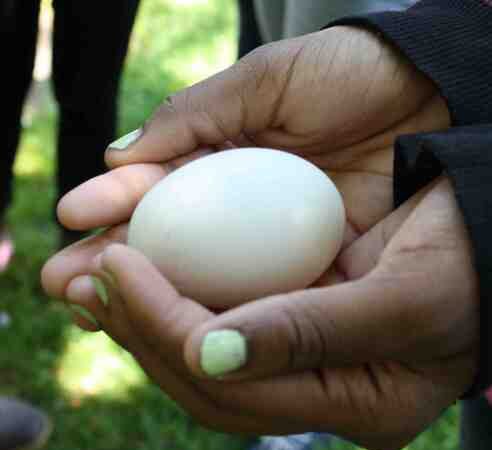
Digging in the Dirt – Small-Batch Earth School


Homemade and handcrafted have better quality, that small-batch cookies you baked in your oven taste better than packaged, store-bought cookies, and the same principle is true for teaching children.
The saying that Earth School has grown by is “small is sustainable.” It’s an essential principle of Permaculture, and for Something Good in the World it’s always related to our motto: “Small steps towards a big difference.” The concept behind grassroots activism is changing one mind at a time, or one backyard at a time. In education, small groups are key, because the more one on one there is, the more learning there can be. Mass production in education is based on Industrial Revolution motives; it’s the most economical to do large batch production. But everyone knows that homemade and handcrafted have better quality, that small-batch cookies you baked in your oven taste better than packaged, store-bought cookies, and the same principle is true for teaching children.
Whenever a school sends me a bus packed with 50 children to the farm for a two-hour program, I know that the likelihood of me reaching more than a few children is very small. It’s more economical to pack 50 children into a bus designed for 50 children and most schools simply cannot afford to send 25 at a time so that we can divide that class in half and just work with 12 in each group. But when we small-batch Earth School, we can connect with each child and make a greater impact.
Walking with a group of 50 children through the farm, it’s like speaking into a void. It makes me feel desperate. One day I reached out to a teenage girl who looked bored and miserable, as we walked from the farm to the parking lot where the students would board the bus back to school. I simply asked, “Have you ever been to a farm before?” “Yes,” she sighed, and she explained that she had grown up on a farm in Peru. “Peru?!” I exclaimed, “I love Peru! Peru is amazing!” And for a whole minute we talked about how beautiful and powerful the land is there and how she feels when she is there, and she lit up like a 1,000-watt light bulb. This is the purpose of Earth School, in the words of Jean Vanier, these are “little lights of love.”
I recently watched the documentary, “Homestretch,” that follows three case histories through the entire film. Not 50, just three. I learned so much from these three young people about the situation for teens who have no safe home to go to at night, who don’t consider themselves homeless because they do have parents or grandparents, but they are unwanted or neglected.
So where do they go? Where can they find a safe place to sleep and eat? How are they going to do their schoolwork or get a job without a place to live? The film is incredibly moving and important, and it taught me a great deal about the teens I work with from the shelter, who have in some cases been abused, but in many cases simply left behind.

There are shelters with 300 children in them, but the one I work with houses only 12. 300 is more economical, but a shelter with only 12 beds can house siblings who need to stay connected, or children who are ill, or teenage girls who are pregnant, or anyone who needs special care and attention. Today I was at the farm with three children from this small shelter. This was not economical, but it was essential. Each child is coming from a situation at home that requires they be sheltered away from their families, under a court order of protection, and this can last anywhere from 3-6 months to a year or more until they can be returned to a home environment or fostered safely elsewhere. The teens that I meet from the shelter every month arrive in a state of pain, and they wear this on their faces and in their postures.
So I expect when they arrive at the farm that they may be angry, depressed, hurt, have a chip on their shoulder, and I know that they will likely be reticent, often withdrawn. But I also know they are children, and that warmth means everything.
This morning when it was below freezing, they did not want to get out of the car. They did not want to be outdoors. They definitely did not want a hands-on, educational experience.
But I have seen it every time, and this has been month after month, year after year, for the past 10 years of working with these children: they melt. They melt like crayons in the sun. And what causes this melting? It’s different things. Today it was a chicken egg. A girl named D. peeked in the chicken coop, not daring to venture inside, but when she was handed an egg that was just removed from underneath a hen, she smiled. It was the warmth of the egg, its fineness, its blue-green color, the fact that a hen had just laid it, and the knowledge that if the hen sat on it for 21 days, it would hatch into a chick. So D. decided to wrap the egg in her gloves, and for two hours she cradled that egg, she held it underneath her armpit, she insisted that she would hatch this egg. By the end of the two hours, I had given her and the teachers contact information for borrowing an incubator, so that she could scientifically hatch the egg, being that her underarm would not be sufficient, though she was determined to try.
During this same time, another girl named A. simply would not come out of the car.
When she entered the zero carbon footprint, solar powered, mobile classroom, nothing impressed her. She would not look up, would not respond. She took out her makeup and began doing her eyes in a hand held mirror. She was not going to melt.
She tasted the maple sap we had collected while she sat in the car. She was not moved by this. I gave her some boiled sap to taste, and a smile came over her face by accident, when the sweetness hit her tongue. She added more to her glass.
Within one hour, she had become the cook for the day. D. took over the kitchen and prepared gluten-free pancakes with fresh maple syrup for all the students and teachers. She stood as the chef calling out, “You want a pancake? No? Come on!”
A boy named A. would not look at me or speak. He insisted on not wearing a coat in the sub freezing temperature. A teacher had the idea to give him her phone to video the workshop. For the next two hours, he became a cameraman, lit up, smiling, getting good angles, interviewing me, laughing, totally engaged. How simple, how brilliant. “I’m on CNN!” I laughed with him as I gestured to the Sugar Maple tree.
Walking back to the car with the teens at the end, I asked them to go back to the shelter and please write to me about what they learned. They did not respond, just got in the cars and shut the doors, no goodbyes, no thank yous. A minute later, the girl named A. rolled down the window. “You want us to write you about what we learned today?” she asked, her eyes serious. “Yes,” I said, “I am very interested in what you learned.” “OK,” she agreed, nodding.
One of the shelter teachers handed me a packet of letters that the teens had written the previous month. It was a different group, but we’d had the same experience.
One girl in particular had not been willing to participate or speak until we got to the part of the workshop where we sat indoors in front of a warming fireplace in the farmhouse, doing needle felting with wool. I opened her letter and read:
Dear Ms. B. and Ms. H.,
I really appreciate you inviting us to your lovely farm with all your wonderful animals. My favorite things were the baby sheep and the creative felting. You were right it does help you relax and stay calm. It was a fantastic experience while visiting your farm. The food you have given us to taste was amazing, it was very unique, it’s always wonderful to try new things in life. I loved your leadership towards us and all the knowledge you have filled our brains with. Thank you guys for all of your support and being wonderful leaders towards us.
Sincerely,
L. G.
The situation for at-risk youth has not changed in the past 12 years of my experience working with these teens. I can only quote a philanthropist who I heard interviewed once on PBS’ “Beyond the Color Line,” who said, “If you don’t consider disadvantaged youth, if you say you don’t care, that it’s not important, you are so wrong. That is like sitting in a rowboat and there’s water coming into the boat and you don’t bail it out because you say, ‘The hole isn’t under my seat.’”
In a small-batch version of that rowboat, we would all recognize that the water is coming in, and it’s our responsibility to bail it out, one bucket at a time.
